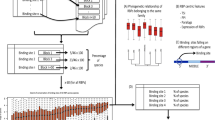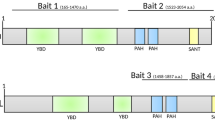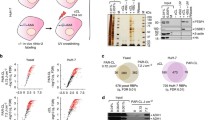Abstract
Rb exerts important physiological functions in cell-cycle control, gene expression, cell differentiation, apoptosis, development and tumorigenesis by interacting with many cellular proteins. Using human partial Rb as bait, we screened a human fetal brain cDNA library through yeast two-hybrid system and obtained six novel cDNA fragments. Among them, one cDNA fragment corresponds to two different transcripts, 7 kb and 9 kb in Northern blot analysis. These two transcripts showed uniform distribution in various human tissues. We cloned the full-length cDNA of a 7.2 kb transcript through three times PCR amplifications. It was namedRAP140a and predicted to encode a 1 233 amino acids hydrophilic protein.RAP140a was mapped to chromosome 3p13-p14. 1. RAP140a may be functionally related to the intracellular translocation of Rb or other proteins.
Similar content being viewed by others
References
Weinberg, R. A., The retinoblastoma protein and cell cycle control, Cell, 1995, 81: 323.
Bartek, J., Bartkova, J., Lukas, J., The retinoblastoma protein pathway and the restriction point, Curr. Opin. Cell. Biol., 1996, 8: 805.
Mittnacht, S., Control of Rb phosphorylation, Curr. Opin. Genet. Devel., 1998, 8: 21.
Macleod, K., Rb and E2F-1 in mouse development and tumorigenesis, Curr. Opin. Genet. Dev., 1999, 9: 31.
Chen, P. L., Riley, D. J., Chen, Y. et al., Retinoblastoma protein positively regulates terminal adipocyte differentiation through direct interactions with C/EBPs, Genes Dev., 1996, 10: 2794.
Luo, R. X., Postigo, A. A., Dean, D. C., Rb interacts with histone deacetylase to repress transcription, Cell, 1998, 92: 463.
Fields, S., Song, O., A novel genetic system to detect protein-protein interactions, Nature, 1989, 340: 245.
Fields, S., Sternglanz, R., The two-hybrid system: an assay for protein-protein interactions, Trends Genet., 1994, 10: 286.
Feilotter, H. E., Hannon, G. J., Ruddel, C. J. et al., Construction of an improved host strain for two hybrid screening, Nucleic Acid Res., 1994, 22: 1502.
Van Aelst, L., Barr, M., Marcus, S. et al., Complex formation between RAS and RAF and other protein kinases, Proc. Natl. Acad. Sci. USA, 1993, 90: 6213.
Bartel, P. L., Chien, C. T., Sternglanz, R., Elimination of false positives that arise in using the two-hybrid system, Bio-Techniques, 1993, 14: 920.
Sambrook, J., Fritsch, E. F., Maniatis, T., Molecular Cloning: A Laboratory Manual, 2nd ed., New York: Cold Spring Harbor Laboratory Press, 1989.
He, K. L., Gu, B. W., Zhang, Q. H. et al., Application of radiation hybrid techniques in chromosomal localizations, Science in China (in Chinese), Ser. C, 1999, 29(1): 108.
Altschul, S. F., Gish, W., Miller, W. et al., Basic local alignment search tool, J. Mol. Biol., 1990, 215(3): 403.
Kyte, J., Doolittle, R. F., A method for displaying the hydrophobic character of a protein, J. Mol. Biol., 1982, 157: 105.
Chou, P. Y., Fasman, G. D., Prediction of the secondary structure of proteins from their amino acid sequence, Adv. Enzyme Regul., 1978, 47:45.
Reinhardt, A., Hubbard, T., Using neural networks for prediction of the subcellular location of proteins, Nucleic Acids Res., 1998, 26(9): 2230.
Wang, J. Y. J., Knudsen, E. S., Welch, P. J., The retinoblastoma tumor suppress protein, Adv. Cancer Res., 1994, 64: 25.
Wang, J. Y. J., Retinoblastoma protein in growth suppression and death protection, Curr. Opin. Genet. Dev., 1997, 7: 39.
Fush, E., The cytoskeleton and disease: Genetic diseases of intermediate filament, Ann. Rev. of Genet., 1996, 30: 197.
McLachlan, A. D., Karn, J., Periodic features in the amino acid sequence of nematode myosin rod, J. Mol. Biol., 1983, 164: 605.
Nakajima, H., Hirata, A., Ohawa, Y. et al., A cytoskeleton-related gene, USO1, is required for intracellular protein transport inSaccharomyces cerevisiae, J. Cell Biol., 1991, 113(2): 245.
Dornert, C., Ciossek, T., Muller, S. et al., Characterization of KIF1C, a new kinesin-like protein involved in vesicle transport from the Golgi apparatus to the endoplasmic reticulum, J. Biol. Chem., 1998, 273(32): 20267.
Author information
Authors and Affiliations
Corresponding author
Rights and permissions
About this article
Cite this article
Li, Q., Wen, H. & Ao, S. Identification and cloning of the cDNA of a Rb-associated protein RAP140a. Sci. China Ser. C.-Life Sci. 43, 637–647 (2000). https://doi.org/10.1007/BF02882285
Received:
Issue Date:
DOI: https://doi.org/10.1007/BF02882285




